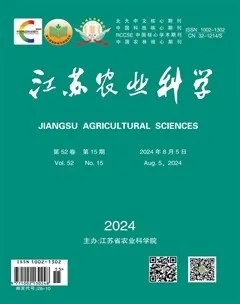基于高光譜成像的水果品質檢測研究進展

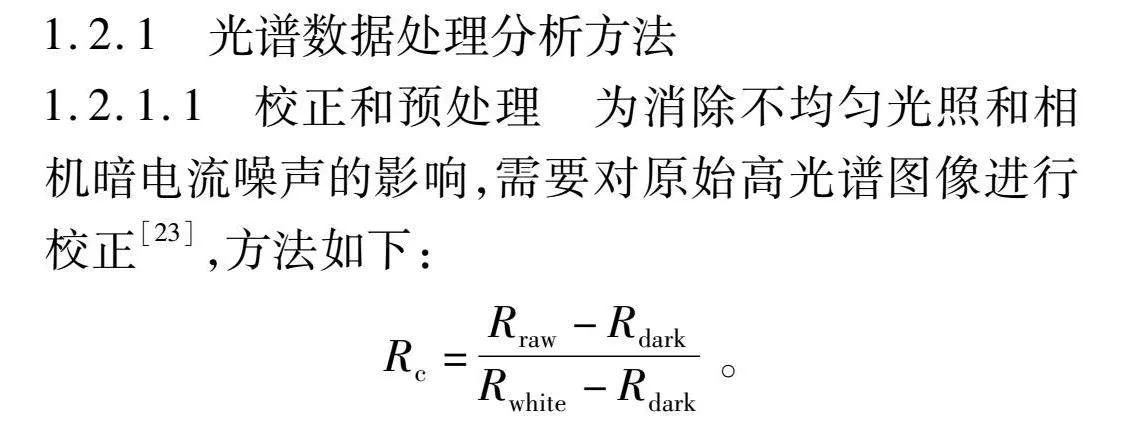


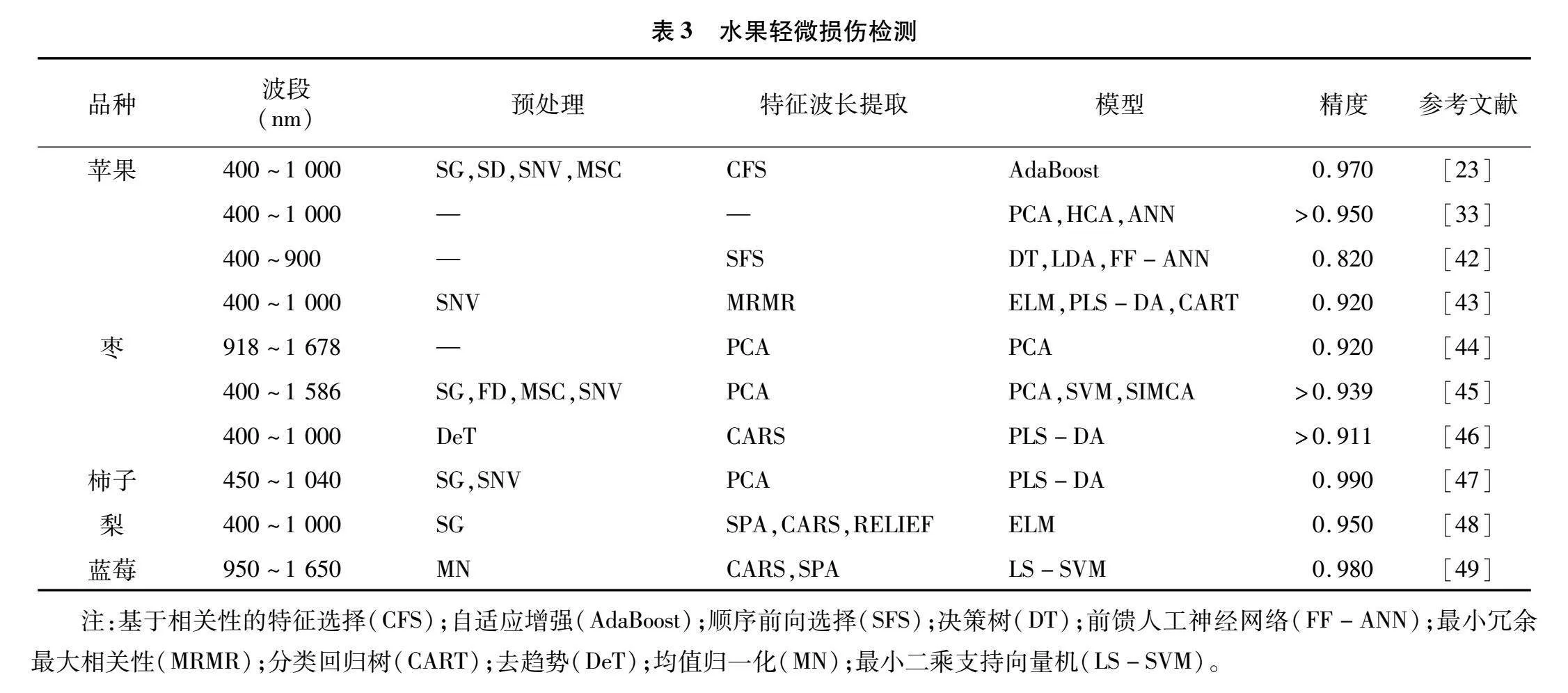

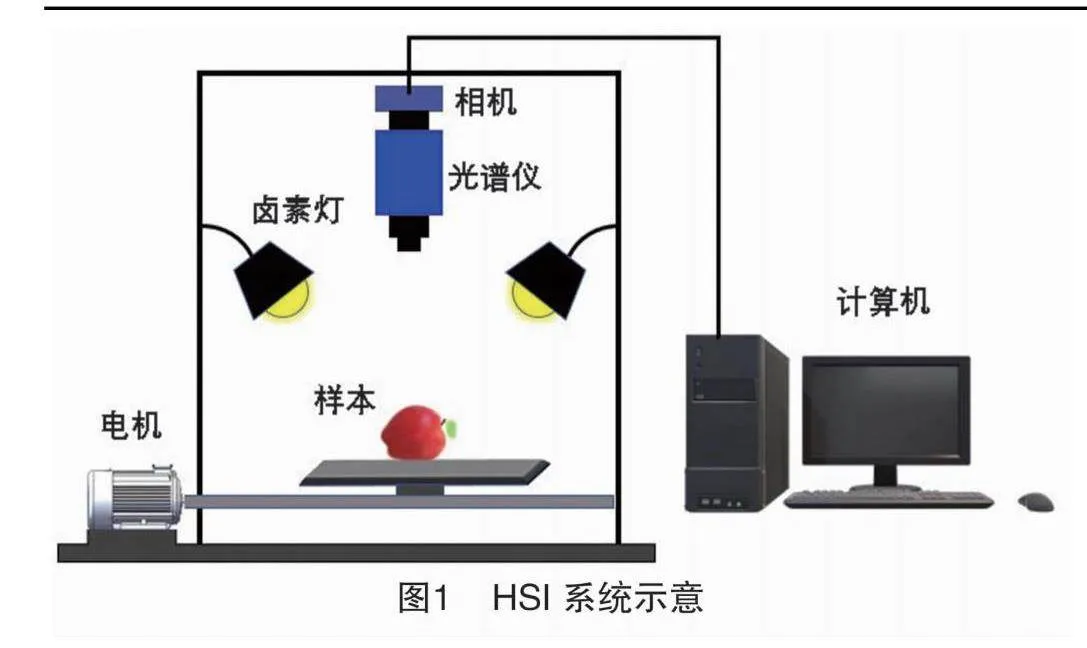
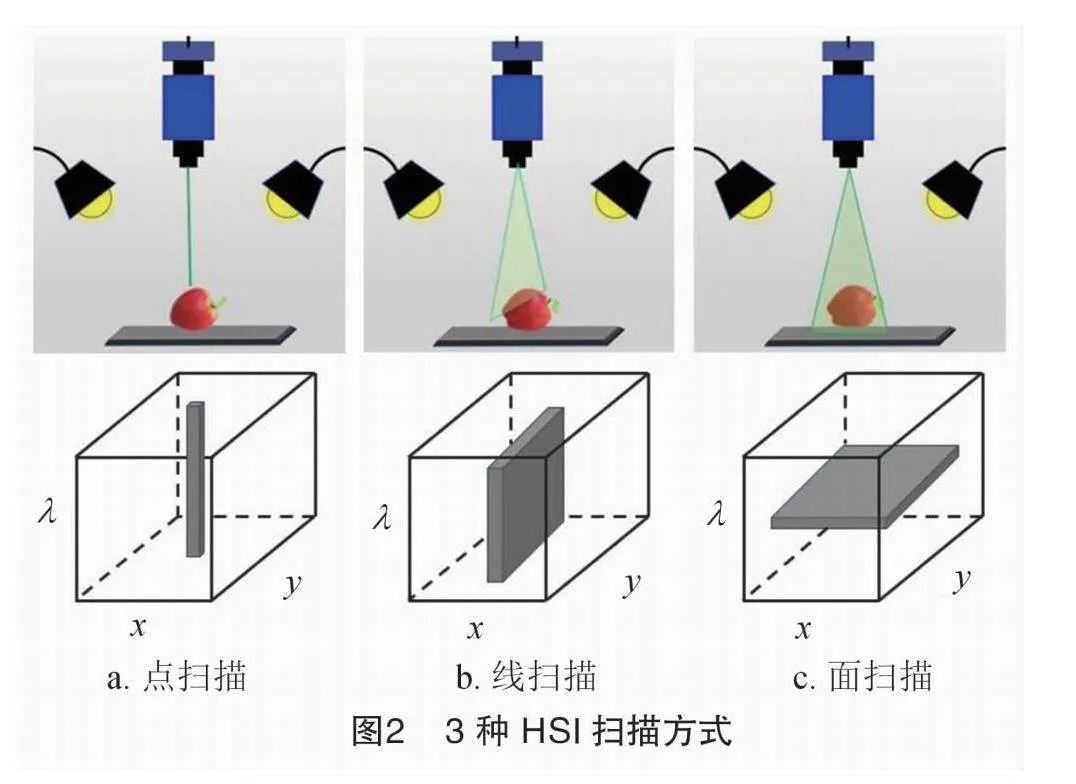


摘要:水果具有較高的經濟價值,實現其品質無損檢測可減少經濟損失并提高市場競爭力,機械分選、機器視覺和化學檢測等方法僅能實現對水果外部或內部品質的單獨檢測,而高光譜成像技術可準確、無損地檢測水果內、外部品質,市場前景廣闊。本文介紹了典型高光譜成像系統的構成,總結了點掃描、線掃描和面掃描3種高光譜數據獲取方式的優、缺點及適用情況,并歸納了常用的光譜校正和預處理方法、特征波長提取方法、建模方法及評價指標,以及常用圖像分割方法的優缺點。綜述了近年利用高光譜成像技術檢測常見水果的表面缺陷、輕微損傷、病菌感染和冷害等外部品質及可溶性固形物含量、干物質含量、硬度和成熟度等內部品質的研究工作,對于外部品質檢測,使用高光譜成像技術獲取圖像數據,提取特征圖像后結合支持向量機、卷積神經網絡等機器學習技術進行品質檢測是目前的主流方法,內部品質通常結合化學檢測和多元回歸方法進行檢測。最后,分析了高光譜成像技術在水果品質無損評估中面臨的挑戰和未來發展趨勢。
關鍵詞:水果;品質;高光譜成像;無損檢測
中圖分類號:TS255.1 文獻標志碼:A
文章編號:1002-1302(2024)15-0016-11
收稿日期:2023-05-20
基金項目:國家留學基金委公派訪問學者項目(編號:201808440136)。
作者簡介:丁世春(1998—),男,四川瀘州人,碩士研究生,從事計算機視覺研究。E-mail:2233429841@qq.com。
通信作者:馬瑞峻,博士,教授,從事農業自動化研究。E-mail:maruijun_mrj@scau.edu.cn。
我國2021年全國果園總面積1 280.8萬hm2,年水果總產量2.997億t[1],均位于世界首位。將采后水果進行分級有利于水果生產、流通等環節的標準化操作,降低成本,并實現優質優價,提高水果市場競爭力。傳統機械分選設備主要針對水果形狀、尺寸和質量[2],無法檢測外部缺陷和內部品質。隨著水果產業規模升級,怎樣實現水果品質準確、無損和快速地檢測問題亟待解決。計算機視覺技術因無損、高效和準確在果蔬外部品質分級領域受到廣泛研究和應用[3-7],除尺寸和形狀外,還能實現對色澤、疤痕和腐爛等品質的檢測,是目前最有可能廣泛應用到實際水果外部品質檢測的技術。
隨著生活水平的提高,消費者同樣注重水果安全問題和內部品質。水果殘留的動物糞便和農藥都會威脅人體健康[8],而含糖量、硬度、干物質含量(DMC)和可溶性固形物含量(SSC)等是水果營養價值的體現。取部分果肉進行理化分析能得到較為準確的內部品質信息,但費時、費力,破壞了水果內部組織,難以滿足大批量檢測的需求。傳統的光譜檢測設備只能進行單點檢測,誤差較大[9-12]。隨著高光譜成像(HSI)技術的發展,已成為目前最先進的水果品質無損檢測技術之一[13-15],具有“圖譜合一”的特點,可同時進行內、外部品質檢測,在柑橘[16- 17]、蘋果[18- 19]、棗[20]和獼猴桃[21]等常見水果中得到廣泛研究和應用。
本文介紹了HSI系統的組成和數據處理方法,綜述了HSI在水果表面缺陷、輕微損傷、病菌感染和冷害等外部品質及SSC、DMC、硬度和成熟度等內部品質中的研究應用,總結分析了HSI在水果品質無損檢測中面臨的挑戰和未來發展趨勢。
1 HSI系統和數據處理方法
1.1 HSI數據獲取方式
典型的HSI系統由光源、相機、鏡頭、計算機、輸送機構和成像光譜儀組成。由圖1可知,成像光譜儀將光線分為不同頻率的單波長λ,然后將單波長光投射到相機上,可同時獲取被測對象空間域和光譜域的信息。常見的成像光譜儀光譜范圍包括可見近紅外(400~1 000 nm)、近紅外(900~1 700 nm)和短波紅外(900~2 500 nm)。
根據掃描方式,HSI可分為點掃描、線掃描和面掃描,由圖2可知,點掃描每次僅獲取1個像素點的
信息,需頻繁移動相機或被測對象,常用于檢測微觀對象;線掃描每次可獲取到整條掃描線上所有點的信息,適合對水果進行動態采集,是最常用的掃描方式;不同于點掃描和線掃描在空間域進行,面掃描是在光譜域進行,每次可獲取至單個波長λ下所有像素點的信息,以該方式獲取高光譜圖像時,需要轉動濾光片切換器或調節可調濾波器,因此一般用于所需波長較少的多光譜成像系統中。
根據光源和相機不同的位置關系,HSI又可分為反射、透射和漫透射[22]。由圖3可知,反射模式下光源和采集裝置均位于樣品同一側,光線經過漫反射后進入采集裝置,此模式因易于實施而廣泛應用在水果品質檢測中。但該模式下反射光線所攜帶信息有限,在檢測水果內部品質時,效果較差。透射模式下光源和檢測裝置位于樣品的兩側,光線透過樣品從而攜帶豐富的內部信息。但該模式需要高強度的光源和高靈敏度的采集裝置以獲得足夠的可用信息,實際實施相對困難,且其光線透射率受被測對象的尺寸和形狀影響,較長的光程會使內部品質評估工作復雜化。第3種漫透射模式下光源和采集裝置位于樣品同一側,使用擋板將兩者分隔,有利于評估水果淺層組織的特性。
1.2 高光譜圖像處理方法
高光譜圖像是由不同波段圖像組成的三維立方體,可同時在空間域和光譜域進行處理和分析,也可單獨在空間域或光譜域進行分析,其處理流程見圖4,首先進行校正,然后選擇感興趣區域進行預處理,以光譜和圖像分別分析水果內、外部品質,最后結合兩者完成水果品質分級。
1.2.1 光譜數據處理分析方法
1.2.1.1 校正和預處理
為消除不均勻光照和相機暗電流噪聲的影響,需要對原始高光譜圖像進行校正[23],方法如下:
Rc=Rraw-RdarkRwhite-Rdark 。
式中:Rc是校正后的光譜圖像,Rraw是原始光譜圖像,Rdark是關閉光源,蓋上鏡頭后采集的全暗參考圖像,Rwhite是使用反射率為99%的標準白板得到的全白參考圖像。
光譜數據易受到雜散光、噪聲和基線漂移等因素的干擾[24-25],因此建模前需進行預處理。光譜預處理方法根據處理效果可分為基線校正、散射校正、平滑處理和尺度縮放4類[26-27]。基線校正包括一階導數(FD)、二階導數(SD)和小波變換(WT)等;散射校正包括乘法散射校正(MSC)、標準正態變量(SNV)等;平滑處理主要為SG平滑和高斯平滑;尺度縮放包括中心化、Pareto尺度化、最大最小歸一化和標準化等。由于儀器、樣品特征和測量環境的不同,光譜預處理并沒有通用的方法,可根據光譜信號的特征直接選擇預處理方法,但需要豐富的經驗。也可根據建模效果選擇預處理方法,可選擇出最優方法,但數據量較大時十分耗時[28]。
1.2.1.2 特征波長提取
提取特征波長的常用方法包括方差分析法、相關系數法、遺傳算法(GA)、隨機蛙跳(RF)、模擬退火(SA)、主成分分析(PCA)、無信息變量消除法(UVE)、競爭性自適應重加權取樣法(CARS)和連續投影算法(SPA)。
1.2.1.3 建模方法及評價指標
高光譜圖像數據具有多重共線性和高維度的特點,通常選擇多元分析方法建模分析數據和目標特征的關系,多元分析方法又可分為定量分析和定性分類。
典型的定量分析方法有支持向量機(SVM)、人工神經網絡(ANN)、主成分回歸(PCR)、偏最小二乘回歸(PLSR)、支持向量回歸(SVR)、多元線性回歸(MLR)和逐步線性回歸(SLR)。常用的模型性能評價指標包括相關系數(R)、確定系數(R2)、均方根誤差(RMSE)和殘差預測偏差(RPD)。通常來說,預測效果較好的模型R2接近1,RPD>2.5且RMSE盡量小。
常用的定性分類方法包括ANN、SVM、PCA、聚類、K-最近鄰(KNN)、線性判別分析(LDA)和偏最小二乘判別分析(PLS-DA)。通常以準確率和誤判率評價模型分類效果[29],模型準確率越接近100%,誤判率越接近0,模型分類效果越好。
1.2.2 圖像處理方法
圖像中的主要特征包括顏色、形狀、紋理和空間關系,可反映水果的缺陷、病害等信息。圖像處理流程主要包括預處理、分割和特征提取,預處理方法包括像素亮度變換、幾何變換、局部鄰域預處理;分割方法主要基于閾值、區域、邊緣和深度學習。由表1可知,特征提取方法有Canny邊緣檢測、Harris角點提取、尺度不變特征變換、方向梯度直方圖、局部二值模式和卷積神經網絡(CNN)等。
2 HSI在水果品質檢測中的應用
2.1 外部品質檢測
水果外部品質包括尺寸、形狀、顏色、缺陷、污染和病菌感染等,是影響消費者購買選擇的主要因素。目前,機器視覺技術可較好地檢測尺寸、形狀、顏色等特征顯著的表面品質[30-31],但基本無法檢測特征不明顯的輕微損傷、凍傷和早期病菌感染等品質。而HSI具有圖譜合一的特點,檢測水果隱性損傷時具有較大優勢。
2.1.1 表面缺陷
水果表面缺陷檢測主要基于缺陷的顏色、形狀、亮度和紋理,HSI彌補了傳統彩色成像的缺點,在較多波長處成像,可凸顯不明顯的特征。目前,利用HSI檢測水果表面缺陷面臨的主要問題是如何采集水果較為完整的表面信息以及解決眩光、果莖和果萼的干擾。
HSI掃描成像時水果速度較低,且常規掃描方法單次掃描僅能獲取到水果約50%的表面信息,旋轉掃描可將其提高到95%以上,可有效提高檢測準確率,但目前的旋轉掃描系統無法完成連續、自動的水果信息采集,為滿足流水線檢測的需求有待進一步改進。眩光會對品質檢測造成不利影響,將其視為一種缺陷特征進行檢測和分類也是可行的[32]。果莖和果萼常會被誤識別為缺陷,極有必要對其進行準確的區分。結合能量、熵、慣性矩和相關性等紋理特征和光譜特征開發的SVM對蘋果果莖、果萼、蟲傷的總體識別率為97.8%[18]。ANN結合哈爾級聯算法(HCA)也能較好地區分蘋果結痂和果莖[33]。
對于柑橘疤痕,Zhang等以PCA選取特征波長,利用單色圖像之比(680 nm/715 nm)結合閾值分割得到缺陷區域,測試準確率為96.63%,僅使用2個特征波長可為開發快速的多光譜檢測系統提供參考[34]。對于蘋果的常見缺陷,Zhang等以SVM和最小噪聲分數(MNF)提取高光譜反射圖像的特征波長,提出的(930~730 nm)/930 nm方法可以忽略光照變化,具有較高的穩定性和可移植性[35]。
由表2可知,總結了近年利用HSI檢測水果表面缺陷的相關研究。水果表面缺陷種類豐富,而且各生長、儲存階段的缺陷特征存在較大差異,很難有統一的檢測標準,通常針對收獲后短期內的水果進行缺陷檢測,可結合HSI分析水果儲存期間缺陷形成的原因,為進一步延長水果保質期提供參考。
2.1.2 輕微損傷
水果輕微損傷通常是水果在采摘和運輸過程中受外部擠壓、撞擊形成,一般在果皮之下,和正常組織的差異較小,很難通過肉眼進行識別,尤以果皮顏色較深時為甚。輕微損傷會導致果肉進一步褐變甚至腐爛,降低水果的商品價值,所以在其形成初期進行檢測及剔除具有重要的經濟意義。獼猴桃、草莓和蘋果等薄皮水果極易產生輕微損傷,相關研究見表3。
輕微損傷的嚴重程度通常從其產生區域中央向四周逐漸減弱,為使數據更加均勻,Pan等將蘋果瘀傷區域劃分為10等份進行數據重采樣,并對比DT、隨機森林(RF)、極致隨機化樹(ERT)、梯度增強決策樹(GBDT)等模型使用重采樣數據和原始數據的效果,發現模型準確率均有所提高[50]。對于光譜數據的預處理,質子分析法可使光譜分布更加多樣化,利用分段非線性擬合提取的特征波長檢測蘋果瘀傷的效果優于常用的SPA、GA和PCA[51]。Huang的團隊開發了一套基于780、850、960 nm的多光譜蘋果瘀傷檢測系統,對比了蘋果在靜態和動態條件下的檢測效果,發現動態條件下檢測準確率急劇下降,主要原因是運動狀況下850、960 nm波長的圖像質量下降。為提高HSI的實際應用效果,應更加注重動態條件下的分析和測試[52]。
ResNet[53]、VGG16[54]、Inception[55]和YOLO v3[56]等深度學習模型在水果輕微損傷檢測領域也有廣泛應用。相比傳統的機器學習模型,此類模型的準確率更高、魯棒性更強,但模型的性能主要取決于數據集的數量和質量,而且訓練耗時。
有研究表明,近紅外光譜區域的高光譜圖像比可見光區域和可見近紅外光區域能更有效地檢測水果瘀傷組織,因為瘀傷區域的含水量高于正常組織,而含水量的光譜響應主要在近紅外區域,引入可見光譜區域進行分析時可能會削弱損傷區域和正常組織之間的光譜強度差異[57]。
以上研究表明,利用高光譜圖像能夠很好地完成水果輕微損傷的檢測,絕大多數研究選擇完好水果然后在其赤道處制造輕微損傷,但實際損傷產生的位置具有很強的隨機性,且通常伴有會對損傷檢測造成極大干擾的其他缺陷。此外,對損傷嚴重程度的判斷十分主觀,缺乏相應的依據和標準,所以未來的研究應確保輕微損傷位置的隨機性,探究如何從眾多缺陷中準確地檢測出輕微損傷,并制定相應的損傷程度等級標準。
2.1.3 早期病菌感染
病菌容易入侵水果損傷和果蒂處,且造成的感染在水果運輸和儲藏期間較難防治,容易在短時間內迅速擴大,所以檢測早期階段的病菌感染有極高的必要性,相關研究見表4。
為快速獲取到一定數量的病菌感染水果,通常以人工接種病菌的方式制造感染。為選取柑橘早期感染的最佳檢測波段,Li等采集反射高光譜圖像,以500~1 050 nm光譜范圍內的7個波長圖像構建多光譜圖像,使用BEMD去噪,對比Otsu和WSA分割感染區域的效果,發現由于不同波段的各個主成分圖中缺陷的強度差別較大,且柑橘彎曲的表面會造成光線分布不均,Otsu效果較差,可使用來自不同品種、批次和種植區域的更多樣本來優化圖像處理算法[58]。Tian等以透射高光譜圖像檢測柑橘早期感染,結合偽彩色圖和WSA能準確地分割出感染區域和果梗區域,對感染柑橘的檢測準確率為93%。但以被分割區域的像素個數和周長像素個數判斷該區域是否為果梗,結果易受相機安裝位置及圖像大小等影響,缺乏穩定性和普適性[14]。Quoc等使用ANN和SVM 這2種分類器進行逐像素點分類檢測棗的銹斑和霉菌等感染,使用全波段圖像時,ANN和SVM的處理時間分別為25 s和 320 s。為減少處理時間,以等間隔和PCA方式各選取14個波長,2種方式下ANN和SVM的準確率為950%、94.9%和95.0%、94.6%,且使用等間隔波長時檢測時間分別減少到16.6 s和30.0 s,可區分出眩光區域,準確率較高,但檢測時間有待進一步減少[15]。
各種機器學習和神經網絡模型也被廣泛應用于水果早期病菌感染檢測中,使用反射高光譜圖像訓練的ResNet101對感染炭疽病5 d后的橄欖識別準確率可達100%,但數據量較少,模型泛化能力弱,應采集更多各感染時期的圖像[67]。Sandra等對枇杷的紫斑等感染進行識別,對比RF、XGBoost和PLS的效果,XGBoost識別效果最佳。但該研究使用的是450~1 040 nm全波段,應進一步選取特征波長減少處理時間[40]。
HSI不同的采集模式均可準確地檢測出水果淺層組織的早期病菌感染,但檢測時間仍有待進一步減少以滿足實際需求,且對水果內部感染的研究較少,而內部感染很容易導致消費者誤食被感染的果肉,危害人體健康,可展開深入研究。
2.1.4 冷害
冷害是指由0 ℃以上的低溫造成的傷害。香蕉、芒果和菠蘿等亞熱帶及熱帶水果都對冷害較為敏感,水果發生冷害后,可能會變色、萎縮,甚至腐爛。
高光譜圖像結合ANN可較好地檢測蘋果冷害[68],Sun等為檢測桃子受冷害程度,采集400~1 000 nm 的反射高光譜圖像,建立了PLS-DA、ANN和SVM判別模型,結果表明,使用全波長數據時ANN分類效果最佳,可實現對非冷害、輕度冷害、中度冷害和重度冷害的區分。又以SPA選擇6個最佳波長作為PLS、費舍爾線性判別分析、ANN和SVM的輸入,也能較好地區分冷害和非冷害。此外,還對圖像進行PCA生成了冷害的分布圖。結果表明,反射高光譜圖像無損檢測桃子冷害是可行的[69]。Lu等研究發現,使用5.03 nm的光譜分辨率以及 20 mm/s 的速度掃描效率較高,適合檢測青棗冷害。以RF提取最佳波長,建立的LDA模型對非冷害、輕度冷害和重度冷害的總體分類準確率為93.3%[70]。
HSI已成功用于識別蘋果、棗和桃的冷害,但對亞熱帶及熱帶地區更易感冷害的水果研究較少。由于不同生長時期的水果遭受冷害時的癥狀各不相同,且有的水果受到冷害時從內部開始惡化,外表仍然完好,可利用高光譜方法開發相關檢測設備,提高檢測效率,降低由冷害造成的損失。
2.2 水果內部品質分析
水果的內部品質指標包括pH值、SSC、DMC、硬度、含糖量、可滴定酸(TA)等,HSI已被廣泛用于水果內部品質的評估(表5)。
2.2.1 SSC
SSC是水果中所有可溶于水的化合物的總稱,包括糖、酸、礦物質、維生素等,是水果最重要的內部品質評價指標之一。目前,研究仍以反射成像為主,透射和漫透射方式較少。為提高蘋果SSC的預測準確率,Fan等結合反射高光譜圖像和紋理灰度共生矩陣建立的PLSR模型預測效果優于單獨使用反射高光譜圖像,使用CARS選取特征波長,建立的模型效果優于使用全波段,預測集和驗證集的R及RMSE分別為0.932 7%、0.641 0%和0913 0%、0.665 6%[90]。
對于不同產地蘋果的SSC,使用反射高光譜圖像也有較好的預測效果,以SPA選取特征波長建立LS-SVM模型,預測集的R和RMSE分別為0878、0908 Brix[91]。為預測2種獼猴桃的SSC,Guo等采集反射高光譜圖像,使用基于聯合x-y距離方法劃分訓練集和驗證集,使用單個品種建模時,以SPA選擇9個特征波長,2個品種則選擇19個特征波長,對比PLS和LS-SVM模型使用全波段及特征波長的效果,LS-SVM較優,以2個品種建模時,使用全波段的效果優于特征波長,預測集的R和RMSE分別為0.911和1.137,表明開發多品種檢測模型有助于減少計算誤差和提高計算速度[21]。
Zhang等利用透射圖像檢測臍橙的SSC,通過蒙特卡羅異常值檢測方法消除樣本中的潛在異常值,以CARS-SPA選取有效波長建立LS-SVM模型,預測集的R為0.9,RMSE為0.4。但僅使用了單個品種臍橙的單批次樣本,需使用更多的樣本以增強模型泛化能力[92]。
HSI檢測水果SSC的多數研究集中于水果赤道位置,為得到更全面的檢測結果,可利用不同算法對水果的不同位置進行檢測,以HSI反射成像模式檢測SSC的分布是未來的主要方向。檢測小型水果時,HSI的反射模式可獲取到足夠的檢測信息,如草莓、獼猴桃等,但對于西瓜、菠蘿等大型厚皮水果,反射模式很難有較好的效果,可結合多種模式進行對比分析,探索更有效的檢測方案。
2.2.2 硬度
硬度表示水果的抗壓能力,不同水果之間區別極大,是衡量鮮果品質和貯藏性狀的重要指標。為預測不同顏色李子的硬度,Meng等利用反射圖像建立了基于全波段的PLSR和PCR模型,又以SPA和CARS選取特征波長建立了MLR和BPNN模型,結果表明,CARS-MLR預測效果最佳,其對硬度的決定系數R2>0.6,RPD>1.8[93]。
Xu等結合SAE、PLS和LS-SVM建立了巨峰葡萄硬度的預測模型,結果表明SAE-LSSVM模型性能最佳,其預測集對硬度的R2、RMSE和RPD分別為0.92、0.442 2 N、3.26,表明SAE可作為處理高維高光譜圖像數據的替代方案[94]。Yu等結合SAE和FNN建立了梨的硬度預測模型,預測集對硬度的R2、RMSE、RPD分別為0.89、1.81 N、3.05。但該研究中高光譜掃描的速度僅1.5 mm/s,很難滿足實時應用,應進一步研究如何以更快的速度獲取高光譜圖像[95]。
HSI已用于檢測蘋果、桃、李和哈密瓜等多種水果的硬度,且基于硬度對水果成熟度進行分類也展現出較大的潛力,但還需要通過增加樣本規模和改善測量條件等方法實現進一步改進。
2.2.3 成熟度
水果成熟度由酸度、含糖量和硬度等多種指標共同決定,對其進行準確判斷對水果分級和保鮮具有重要意義。為方便運輸和存儲,香蕉通常在未成熟時采摘,所以準確地判斷成熟度可確定合理的采摘時間,Chu等將香蕉劃分為6個成熟度,并測量香蕉成熟過程中SSC、TA、葉綠素含量和總色素含量的變化,以果梗、果萼和香蕉中部的光譜信息建立PLS-DA預測模型,以全波段建立的模型性能優于特征波段[96]。Juan等以整簇葡萄的SSC、TA、pH值、酒石酸、蘋果酸、花青素和總酚建立預測成熟度的PLS模型,測試結果表明該模型可實現對整簇葡萄成熟度的預測,但采集的只是整簇水果一個表面的光譜信息,缺乏代表性,預測效果較差[97]。Shao等將草莓分為成熟、中熟和未成熟3個階段,采集草莓位于室內和田間時的光譜信息,建立了PLS-DA和LS-SVM預測模型,田間評估時的準確率分別為91.7%和96.7%,略低于室內環境,而且以CARS方法選取特征波長建立的LS-SVM模型預測效果更好,可用于田間草莓成熟度的實時評估[98]。
不同水果的成熟度評價指標不同,多數研究僅針對相同產地的單一品種進行成熟度檢測,模型的適用范圍較低,可同時對多品種展開研究,增強模型泛化能力。
3 展望
水果經濟價值較高,實現其采后品質分級可有效減少損失,增強市場競爭力。隨著水果產業的快速發展,需實現快速、準確、無損和全面的品質檢測。HSI可無損檢測水果內外部品質,已有許多研究結合HSI和化學計量學成功實現了水果的品質檢測,但仍很難應用到實際檢測中,可結合以下幾個方面展開深入研究。
3.1 優化輸送設備和照明條件
在常規的水平輸送方式下,HSI系統只能獲取到水果約50%的表面信息,容易造成誤檢和漏檢。也有研究將水果進行旋轉以采集更多的信息,但通常是人工更換水果,不能實現自動、連續采集,難以滿足流水線檢測的需求。而某些表面光滑的水果極易形成眩光,給表面品質檢測帶來極大的干擾,應進一步優化輸送設備和照明條件以滿足實際應用。
3.2 加強水果動態下的品質檢測
水果處在靜態或極緩慢運動狀態下HSI系統可采集最準確的品質信息,實現最準確的品質檢測,但批量檢測時需要水果具有一定的速度,會大幅降低成像質量。目前,關于如何克服動態檢測時成像質量降低的研究較少,缺少科學的解決方案。
3.3 多源信息、多模式融合
HSI檢測中、小型薄皮水果內部品質效果較好,但獲取大型厚皮水果的內部品質信息較為困難,已有的研究主要分析西瓜、哈密瓜和甜瓜3種厚皮水果,而對表面粗糙、果殼密度大的榴蓮、菠蘿蜜等研究較少,可結合X射線和核磁共振等穿透力較強的技術進行深入研究。對于特定的樣本,不同HSI模式下獲得的信息具有不同的優勢,所以,多模式結合的HSI系統可提供同一樣本更全面的信息,可為開發更準確的HSI系統提供參考。
3.4 提高模型通用性
基于HSI的水果品質檢測研究通常聚焦于特定品種、特定產地、特定采摘批次水果的特定品質,做了較多的重復工作,效率較低。但不同的水果品質檢測研究中使用的HSI技術是相通的,且不同的水果品質檢測研究面臨的難點也有相似之處,因此,開展品質檢測時可適當統籌,對不同水果的同一品質,以及同一水果的不同品質可以同時展開研究,利用技術的通用性加快研究進展。
參考文獻:
[1]國家統計局. 中國第三產業統計年鑒:2022[M]. 北京:中國統計出版社,2022.
[2]李 梅. 水果分揀技術的研究現狀與發展[J]. 江蘇理工學院學報,2018,24(2):121-124.
[3]高 輝,馬國峰,劉偉杰. 基于機器視覺的蘋果缺陷快速檢測方法研究[J]. 食品與機械,2020,36(10):125-129,148.
[4]王紅軍,熊俊濤,黎鄒鄒,等. 基于機器視覺圖像特征參數的馬鈴薯質量和形狀分級方法[J]. 農業工程學報,2016,32(8):272-277.
[5]田海韜,趙 軍,蒲富鵬. 馬鈴薯芽眼圖像的分割與定位方法[J]. 浙江農業學報,2016,28(11):1947-1953.
[6]何 軍,馬稚昱,褚 璇,等. 基于機器視覺的芒果果形評價方法研究[J]. 現代農業裝備,2021,42(1):56-60.
[7]李 龍,彭彥昆,李永玉. 蘋果內外品質在線無損檢測分級系統設計與試驗[J]. 農業工程學報,2018,34(9):267-275.
[8]張保華,李江波,樊書祥,等. 高光譜成像技術在果蔬品質與安全無損檢測中的原理及應用[J]. 光譜學與光譜分析,2014,34(10):2743.
[9]Huang Y P,Lu R F,Chen K J. Detection of internal defect of apples by a multichannel Vis/NIR spectroscopic system[J]. Postharvest Biology and Technology,2020,161:111065.
[10]Nordey T,Joas J,Davrieux F,et al. Robust NIRS models for non-destructive prediction of mango internal quality[J]. Scientia Horticulturae,2017,216:51-57.
[11]Wang J H,Wang J,Chen Z,et al. Development of multi-cultivar models for predicting the soluble solid content and firmness of European pear (Pyrus communis L.) using portable vis-NIR spectroscopy[J]. Postharvest Biology and Technology,2017,129:143-151.
[12]Zhang D Y,Xu L,Wang Q Y,et al. The optimal local model selection for robust and fast evaluation of soluble solid content in melon with thick peel and large size by vis-NIR spectroscopy[J]. Food Analytical Methods,2019,12(1):136-147.
[13]遲 茜,王轉衛,楊婷婷,等. 基于近紅外高光譜成像的獼猴桃早期隱性損傷識別[J]. 農業機械學報,2015,46(3):235-241,234.
[14]Tian X,Fan S X,Huang W Q,et al. Detection of early decay on citrus using hyperspectral transmittance imaging technology coupled with principal component analysis and improved watershed segmentation algorithms[J]. Postharvest Biology and Technology,2020,161:111071.
[15]Thien Pham Q,Liou N S. The development of on-line surface defect detection system for jujubes based on hyperspectral images[J]. Computers and Electronics in Agriculture,2022,194:106743.
[16]Zhang H L,Chen Y,Liu X M,et al. Identification of common skin defects and classification of early decayed Citrus using hyperspectral imaging technique[J]. Food Analytical Methods,2021,14(6):1176-1193.
[17]章海亮,高俊峰,何 勇. 基于高光譜成像技術的柑橘缺陷無損檢測[J]. 農業機械學報,2013,44(9):177-181.
[18]田有文,程 怡,王小奇,等. 基于高光譜成像的蘋果蟲傷缺陷與果梗/花萼識別方法[J]. 農業工程學報,2015,31(4):325-331.
[19]Che W K,Sun L J,Zhang Q,et al. Pixel based bruise region extraction of apple using Vis-NIR hyperspectral imaging[J]. Computers and Electronics in Agriculture,2018,146(C):12-21.
[20]Liu G S,He J G,Wang S L,et al. Application of near-infrared hyperspectral imaging for detection of external insect infestations on jujube fruit[J]. International Journal of Food Properties,2016,19(1):41-52.
[21]Guo W C,Zhao F,Dong J L. Nondestructive measurement of soluble solids content of kiwifruits using near-infrared hyperspectral imaging[J]. Food Analytical Methods,2016,9(1):38-47.
[22]Lu Y Z,Huang Y P,Lu R F. Innovative hyperspectral imaging-based techniques for quality evaluation of fruits and vegetables:a review[J]. Applied Sciences,2017,7(2):189.
[23]Zhang M Li G H. Visual detection of apple bruises using AdaBoost algorithm and hyperspectral imaging[J]. International Journal of Food Properties,2018 21(1): 1598-1607.
[24]Devos O,Downey G,Duponchel L. Simultaneous data pre-processing and SVM classification model selection based on a parallel genetic algorithm applied to spectroscopic data of olive oils[J]. Food Chemistry,2014,148:124-130.
[25]Liu Y J,Yu Y D,Zhou X G,et al. A new automatic threshold selecting criteria for spectroscopy data processing[J]. Chemometrics and Intelligent Laboratory Systems,2017,161:8-14.
[26]Gerretzen J,Szymańska E,Jansen J J,et al. Simple and effective way for data preprocessing selection based on design of experiments[J]. Analytical Chemistry,2015,87(24):12096-12103.
[27]Engel J,Gerretzen J,Szymańska E,et al. Breaking with trends in pre-processing?[J]. TrAC Trends in Analytical Chemistry,2013,50:96-106.
[28]第五鵬瑤,卞希慧,王姿方,等. 光譜預處理方法選擇研究[J]. 光譜學與光譜分析,2019,39(9):2800.
[29]Keresztes J C,Goodarzi M,Saeys W. Real-time pixel based early apple bruise detection using short wave infrared hyperspectral imaging in combination with calibration and glare correction techniques[J]. Food Control,2016,66:215-226.
[30]Su Q H,Kondo N,Li M Z,et al. Potato quality grading based on machine vision and 3D shape analysis[J]. Computers and Electronics in Agriculture,2018,152(C):261-268.
[31]Zhang W Z,Hu J,Zhou G X,et al. Detection of apple defects based on the FCM-NPGA and a multivariate image analysis[J]. IEEE Access,2020,8:38833-38845.
[32]Pham Q T,Liou N S. Hyperspectral imaging system with rotation platform for investigation of jujube skin defects[J]. Applied Sciences,2020,10(8):2851.
[33]Balabanov P V,Divin A G,Egorov A S,et al. Vision system for detection of defects on apples using hyperspectral imaging coupled with neural network and Haar cascade algorithm[J]. IOP Conference Series:Materials Science and Engineering,2020,862(5):052058.
[34]Zhang H L,Zhang S,Dong W T,et al. Detection of common defects on mandarins by using visible and near infrared hyperspectral imaging[J]. Infrared Physics & Technology,2020,108:103341.
[35]Zhang B H,Liu L S,Gu B X,et al. From hyperspectral imaging to multispectral imaging:Portability and stability of HIS-MIS algorithms for common defect detection[J]. Postharvest Biology and Technology,2018,137:95-105.
[36]Xie C Q,Lee W S. Detection of citrus black spot symptoms using spectral reflectance[J]. Postharvest Biology and Technology,2021,180:111627.
[37]Liu Y S,Zhou S B,Wu H M,et al. Joint optimization of autoencoder and self-supervised classifier:anomaly detection of strawberries using hyperspectral imaging[J]. Computers and Electronics in Agriculture,2022,198:107007.
[38]Mesa A R,Chiang J Y. Multi-input deep learning model with RGB and hyperspectral imaging for banana grading[J]. Agriculture,2021,11(8):687.
[39]Pan T T,Chyngyz E,Sun D W,et al. Pathogenetic process monitoring and early detection of pear black spot disease caused by Alternaria alternata using hyperspectral imaging[J]. Postharvest Biology and Technology,2019,154:96-104.
[40]Munera S,Gómez-Sanchís J,Aleixos N,et al. Discrimination of common defects in loquat fruit cv.‘Algerie’ using hyperspectral imaging and machine learning techniques[J]. Postharvest Biology and Technology,2021,171:111356.
[41]Li J B,Chen L P,Huang W Q,et al. Multispectral detection of skin defects of bi-colored peaches based on vis-NIR hyperspectral imaging[J]. Postharvest Biology and Technology,2016,112:121-133.
[42]Rady A,Ekramirad N,Adedeji A A,et al. Hyperspectral imaging for detection of codling moth infestation in GoldRush apples[J]. Postharvest Biology and Technology,2017,129:37-44.
[45]Wu L G,He J G,Liu G S,et al. Detection of common defects on jujube using Vis-NIR and NIR hyperspectral imaging[J]. Postharvest Biology and Technology,2016,112:134-142.
[43]Zhu X L,Li G H. Rapid detection and visualization of slight bruise on apples using hyperspectral imaging[J]. International Journal of Food Properties,2019,22(1):1709-1719.
[44]吳龍國,王松磊,康寧波,等. 基于高光譜成像技術的靈武長棗缺陷識別[J]. 農業工程學報,2015,31(20):281-286.
[45]Wu L G,He J G,Liu G S,et al. Detection of common defects on jujube using Vis-NIR and NIR hyperspectral imaging[J]. Postharvest Biology and Technology,2016,112:134-142.
[46]Yuan R R,Liu G S,He J G,et al. Classification of Lingwu long jujube internal bruise over time based on visible near-infrared hyperspectral imaging combined with partial least squares-discriminant analysis[J]. Computers and Electronics in Agriculture,2021,182:106043.
[47]Munera S,Rodríguez-Ortega A,Aleixos N,et al. Detection of invisible damages in ‘Rojo Brillante’ persimmon fruit at different stages using hyperspectral imaging and chemometrics[J]. Foods,2021,10(9):2170.
[48]Fang Y M,Yang F,Zhou Z,et al. Hyperspectral wavelength selection and integration for bruise detection of Korla pears[J]. Journal of Spectroscopy,2019,2019:6715247.
[49]Fan S X,Li C Y,Huang W Q,et al. Detection of blueberry internal bruising over time using NIR hyperspectral reflectance imaging with optimum wavelengths[J]. Postharvest Biology and Technology,2017,134:55-66.
[50]Pan X Y,Sun L J,Li Y S,et al. Non-destructive classification of apple bruising time based on visible and near-infrared hyperspectral imaging[J]. Journal of the Science of Food and Agriculture,2019,99(4):1709-1718.
[51]Tang Y,Gao S J,Zhuang J J,et al. Apple bruise grading using piecewise nonlinear curve fitting for hyperspectral imaging data[J]. IEEE Access,2020,8:147494-147506.
[52]Huang W Q,Li J B,Wang Q Y,et al. Development of a multispectral imaging system for online detection of bruises on apples[J]. Journal of Food Engineering,2015,146:62-71.
[53]Wang Z D,Hu M H,Zhai G T. Application of deep learning architectures for accurate and rapid detection of internal mechanical damage of blueberry using hyperspectral transmittance data[J]. Sensors,2018,18(4):1126.
[54]Zhang M Y,Jiang Y,Li C Y,et al. Fully convolutional networks for blueberry bruising and calyx segmentation using hyperspectral transmittance imaging[J]. Biosystems Engineering,2020,192:159-175.
[55]Gai Z D,Sun L J,Bai H Y,et al. Convolutional neural network for apple bruise detection based on hyperspectral[J]. Spectrochimica Acta Part A:Molecular and Biomolecular Spectroscopy,2022,279:121432.
[56]Pang Q,Huang W Q,Fan S X,et al. Detection of early bruises on apples using hyperspectral imaging combining with YOLO v3 deep learning algorithm[J]. Journal of Food Process Engineering,2022,45(2):1-14.
[57]Luo W,Zhang H L,Liu X M. Hyperspectral/multispectral reflectance imaging combining with watershed segmentation algorithm for detection of early bruises on apples with different peel colors[J]. Food Analytical Methods,2019,12(5):1218-1228.
[58]Li J B,Zhang R Y,Li J B,et al. Detection of early decayed oranges based on multispectral principal component image combining both bi-dimensional empirical mode decomposition and watershed segmentation method[J]. Postharvest Biology and Technology,2019,158:110986.
[59]Tian X,Zhang C,Li J B,et al. Detection of early decay on citrus using LW-NIR hyperspectral reflectance imaging coupled with two-band ratio and improved watershed segmentation algorithm[J]. Food Chemistry,2021,360:130077.
[60]Luo W,Fan G Z,Tian P,et al. Spectrum classification of citrus tissues infected by fungi and multispectral image identification of early rotten oranges[J]. Spectrochimica Acta Part A:Molecular and Biomolecular Spectroscopy,2022,279:121412.
[61]Liu Q,Wei K L,Xiao H,et al. Near-infrared hyperspectral imaging rapidly detects the decay of postharvest strawberry based on water-soluble sugar analysis[J]. Food Analytical Methods,2019,12(4):936-946.
[62]Siedliska A,Baranowski P,Zubik M,et al. Detection of fungal infections in strawberry fruit by VNIR/SWIR hyperspectral imaging[J]. Postharvest Biology and Technology,2018,139:115-126.
[63]Liu Q,Sun K,Peng J,et al. Identification of bruise and fungi contamination in strawberries using hyperspectral imaging technology and multivariate analysis[J]. Food Analytical Methods,2018,11(5):1518-1527.
[64]Zhang B H,Fan S X,Li J B,et al. Detection of early rottenness on apples by using hyperspectral imaging combined with spectral analysis and image processing[J]. Food Analytical Methods,2015,8(8):2075-2086.
[65]Ekramirad N,Khaled A Y,Doyle L E,et al. Nondestructive detection of codling moth infestation in apples using pixel-based NIR hyperspectral imaging with machine learning and feature selection[J]. Foods,2021,11(1):8.
[66]Sun Y,Wei K L,Liu Q,et al. Classification and discrimination of different fungal diseases of three infection levels on peaches using hyperspectral reflectance imaging analysis[J]. Sensors,2018,18(4):1295.
[67]Fazari A,Pellicer-Valero O J,Gómez-Sanchs J,et al. Application of deep convolutional neural networks for the detection of anthracnose in olives using VIS/NIR hyperspectral images[J]. Computers and Electronics in Agriculture,2021,187:106252.
[68]ElMasry G,Wang N,Vigneault C. Detecting chilling injury in Red Delicious apple using hyperspectral imaging and neural networks[J]. Postharvest Biology and Technology,2009,52(1):1-8.
[69]Sun Y,Gu X Z,Sun K,et al. Hyperspectral reflectance imaging combined with chemometrics and successive projections algorithm for chilling injury classification in peaches[J]. LWT,2017,75:557-564.
[70]Lu H D,Yu X J,Zhou L J,et al. Selection of spectral resolution and scanning speed for detecting green jujubes chilling injury based on hyperspectral reflectance imaging[J]. Applied Sciences,2018,8(4):523.
[71]Lan W J,Jaillais B,Renard C M G C,et al. A method using near infrared hyperspectral imaging to highlight the internal quality of apple fruit slices[J]. Postharvest Biology and Technology,2021,175:111497.
[72]Tian X,Li J B,Wang Q Y,et al. A multi-region combined model for non-destructive prediction of soluble solids content in apple,based on brightness grade segmentation of hyperspectral imaging[J]. Biosystems Engineering,2019,183:110-120.
[73]Zhu H Y,Chu B Q,Fan Y Y,et al. Hyperspectral imaging for predicting the internal quality of kiwifruits based on variable selection algorithms and chemometric models[J]. Scientific Reports,2017,7(1):7845.
[74]Hu W H,Sun D W,Blasco J. Rapid monitoring 1-MCP-induced modulation of sugars accumulation in ripening ‘Hayward’ kiwifruit by Vis/NIR hyperspectral imaging[J]. Postharvest Biology and Technology,2017,125:168-180.
[75]Ma T,Xia Y,Inagaki T,et al. Non-destructive and fast method of mapping the distribution of the soluble solids content and pH in kiwifruit using object rotation near-infrared hyperspectral imaging approach[J]. Postharvest Biology and Technology,2021,174:111440.
[76]Silva R,Gomes V,Mendes-Faia A,et al. Using support vector regression and hyperspectral imaging for the prediction of oenological parameters on different vintages and varieties of wine grape berries[J]. Remote Sensing,2018,10(2):312.
[77]Gao S,Xu J H. Hyperspectral image information fusion-based detection of soluble solids content in red globe grapes[J]. Computers and Electronics in Agriculture,2022,196:106822.
[78]Yang B H,Gao Y,Yan Q,et al. Estimation method of soluble solid content in peach based on deep features of hyperspectral imagery[J]. Sensors,2020,20(18):5021-5033.
[79]Pan L Q,Zhang Q,Zhang W,et al. Detection of cold injury in peaches by hyperspectral reflectance imaging and artificial neural network[J]. Food Chemistry,2016,192:134-141.
[80]Munera S,Blasco J,Amigo J M,et al. Use of hyperspectral transmittance imaging to evaluate the internal quality of nectarines[J]. Biosystems Engineering,2019,182:54-64.
[81]Liu Y,Wang H H,Fei Y Q,et al. Research on the prediction of green plum acidity based on improved XGBoost[J]. Sensors,2021,21(3):930.
[82]Gao Q,Wang P,Niu T,et al. Soluble solid content and firmness index assessment and maturity discrimination of Malus micromalus Makino based on near-infrared hyperspectral imaging[J]. Food Chemistry,2022,370:131013.
[83]孫靜濤,馬本學,董 娟,等. 高光譜技術結合特征波長篩選和支持向量機的哈密瓜成熟度判別研究[J]. 光譜學與光譜分析,2017,37(7):2184.
[84]Sun M J,Zhang D,Liu L,et al. How to predict the sugariness and hardness of melons:a near-infrared hyperspectral imaging method[J]. Food Chemistry,2017,218:413-421.
[85]Li Y J,Ma B X,Li C,et al. Accurate prediction of soluble solid content in dried Hami jujube using SWIR hyperspectral imaging with comparative analysis of models[J]. Computers and Electronics in Agriculture,2022,193:106655.
[86]Weng S Z,Yu S,Dong R L,et al. Nondestructive detection of storage time of strawberries using visible/near-infrared hyperspectral imaging[J]. International Journal of Food Properties,2020,23(1):269-281.
[87]Weng S Z,Yu S,Guo B Q,et al. Non-destructive detection of strawberry quality using multi-features of hyperspectral imaging and multivariate methods[J]. Sensors,2020,20(11):3074.
[88]Kang Z L,Geng J P,Fan R S,et al. Nondestructive testing model of mango dry matter based on fluorescence hyperspectral imaging technology[J]. Agriculture,2022,12(9):1337.
[89]Teerachaichayut S,Ho H T. Non-destructive prediction of total soluble solids,titratable acidity and maturity index of limes by near infrared hyperspectral imaging[J]. Postharvest Biology and Technology,2017,133:20-25.
[90]Fan S X,Zhang B H,Li J B,et al. Prediction of soluble solids content of apple using the combination of spectra and textural features of hyperspectral reflectance imaging data[J]. Postharvest Biology and Technology,2016,121:51-61.
[91]Dong J L,Guo W C,Wang Z W,et al. Nondestructive determination of soluble solids content of ‘fuji’ apples produced in different areas and bagged with different materials during ripening[J]. Food Analytical Methods,2016,9(5):1087-1095.
[92]Zhang H L,Zhan B S,Pan F,et al. Determination of soluble solids content in oranges using visible and near infrared full transmittance hyperspectral imaging with comparative analysis of models[J]. Postharvest Biology and Technology,2020,163:111148.
[93]Meng Q L,Shang J,Huang R S,et al. Determination of soluble solids content and firmness in plum using hyperspectral imaging and chemometric algorithms[J]. Journal of Food Process Engineering,2021,44(1):1-9.
[94]Xu M,Sun J,Yao K S,et al. Developing deep learning based regression approaches for prediction of firmness and pH in Kyoho grape using Vis/NIR hyperspectral imaging[J]. Infrared Physics & Technology,2022,120:104003.
[95]Yu X J,Lu H D,Wu D. Development of deep learning method for predicting firmness and soluble solid content of postharvest Korla fragrant pear using Vis/NIR hyperspectral reflectance imaging[J]. Postharvest Biology and Technology,2018,141:39-49.
[96]Chu X,Miao P,Zhang K,et al. Green banana maturity classification and quality evaluation using hyperspectral imaging[J]. Agriculture,2022,12(4):530.
[97]Juan F,Ignacio B,Paz D M. Non-invasive monitoring of berry ripening using on-the-go hyperspectral imaging in the vineyard[J]. Agronomy,2021,11(12):2534.
[98]Shao Y Y,Wang Y X,Xuan G T,et al. Assessment of strawberry ripeness using hyperspectral imaging[J]. Analytical Letters,2021,54(10):1547-1560.

